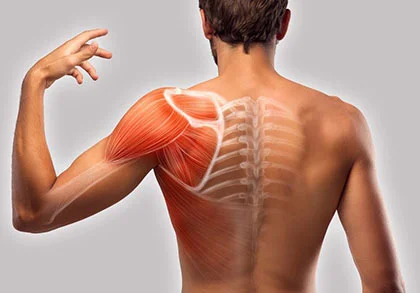Shoulder Pain
Shoulder Pain
Shoulder pain can be insidious. Because the shoulder is made up of so many moving parts, all of which work in concert to allow you full range of motion, there are many ways to damage the area and end up with shoulder blade pain. And then there’s the issue of correctly diagnosing the source of your pain and coming up with the best treatment for shoulder pain specific to that source. The resolution isn’t always cut-and-dried because your discomfort may vary significantly from one moment to the next.

Your Shoulder and Shoulder Pain
Pain in the shoulder can come from too much activity, not enough movement, repetitive motions, underlying medical conditions or accidents. Shoulder pain usually begins in the bones, ligaments, muscles or supporting tissue that make up your shoulder.
The four bones in your shoulder are:
- Clavicle, also called the collarbone
- Humerus, the upper bone in your arms
- Scapula, or shoulder blade
- Acromion, a small bone on top of the joint, where the other three bones meet
You may have heard that sudden left shoulder pain may indicate you’re having a heart attack. In fact, the referred pain from a heart attack can also cause right shoulder pain. But you should treat any sudden, severe shoulder pain, back pain, or neck pain as an emergency.
Most Common Shoulder Pain Causes
Most shoulder pain originates from common damage that may be caused by:
- Injuries. Shoulder ache treatment is often required following a car accident, sports injury or fall that causes damage to any of the structures within your shoulders. If you need emergency shoulder injury treatment in NYC, it’s available at our state-of-the-art clinic.
- Rotator cuff injuries. These are common in athletes and workers who continually raise their arms over their heads — such as carpenters, painters, swimmers, tennis and baseball players. Age also is a factor in rotator cuff injuries.
- Shoulder arthritis. The most common form is osteoarthritis, caused by wear-and-tear over time. It may be age-related or due to infection, work or sports injuries. The pain can be debilitating and severely restrict your mobility.
- Shoulder tendonitis. The strong cords that connect your bones to shoulder muscles are the tendons. They can become inflamed due to a tear or chronic overuse. Tendonitis most commonly appears in the rotator cuff.
- Shoulder bursitis. Fluid-filled sacs that act as cushions between your bones are called bursae. They can become inflamed from overuse. Bursitis often accompanies rotator cuff tendonitis and can be so painful that even brushing your hair is challenging.
- Bicep tendonitis. The pain from a damaged tendon in your arm can radiate to the front of your shoulder. It may be caused by routine repetitive motions or osteoarthritis. Untreated, it can lead to chronic shoulder instability.
- Shoulder impingement. When you lift your arm, it puts pressure on the soft tissues there, like the tendons and bursae in the joint. Without proper shoulder joint pain treatment, this condition can lead to tendonitis and bursitis.
- Rotator cuff tear. Advancing age that weakens the tendons, overuse over a long period, and sudden injuries can partially or completely tear this tendon in your shoulder.
- Frozen shoulder. You feel stiffness and pain that worsens over time with this condition. Also called adhesive capsulitis, it often occurs after a medical procedure or surgery that leaves your arm immobile. If you have right shoulder pain or left shoulder pain from the inactivity, it usually won’t return to the same arm, but can happen on the other side.
- Shoulder sprain or strain. Usually requiring shoulder muscle pain treatment, a strain or sprain often happens when you don’t warm up appropriately before exercising. The inflammation and pain also can occur if you use improper techniques while exercising, from overuse and through repetitive motions.
